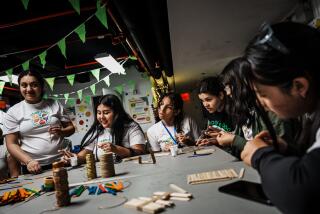Inside the former Walmart that now shelters migrant children: Cots, soccer and a Trump mural
Reporting from Brownsville, Texas — The former Walmart that’s been converted into a migrant shelter housed 1,469 youths Wednesday, enough to fill the high-school-style cafeteria and require added cots in dorm-style bedrooms to handle the overflow.
The Casa Padre shelter in Brownsville drew national attention this month when officials refused to let U.S. Sen. Jeff Merkley (D-Ore.) enter. Merkley, who had shown up at the shelter unannounced, later questioned conditions in the facility and whether the children were properly cared for.
On Wednesday, reporters were allowed to take a quick tour of the facility, run by Austin, Texas-based nonprofit Southwest Key, one of the country’s largest shelter providers for migrant children. Another tour of a Southwest Key shelter is scheduled for Friday in El Cajon, Calif.
The government-contracted shelter has been coping not only with the challenge of housing more youths, but also trying to weed out adults posing as youths (it uses dental records and DNA tests) and preventing runaways. The latter consist of a “small percentage” of the youths held, said company Chief Executive Juan Sanchez, who accompanied the tour.
During the tour, similar to a press tour of emergency shelters for migrant youths at a Texas Air Force base in 2014, reporters were not allowed to photograph or film. (The Department of Health and Human Services later released photographs it had taken inside the facility.) No interviews were allowed of youths or staff members, except those leading the tour.
Tour leaders sped through the facility, making presentations along the way, accompanied by a Health and Human Services spokesman. The department contracts with the shelters to care for youths whom it is required to take into custody from Homeland Security within 72 hours of their apprehension.
The shelter is state-licensed for 1,200 beds but received a variance from state officials to house 297 more youths because of the latest influx of immigrants. There are more than 1,367 staff members in the 250,000 square foot shelter. The facility has added workers to keep the staffing ratio within state requirements, director Martin Hinojosa said. The average stay is 49 days.
The shelter housed only boys this week, more than 70% of whom arrived at the border unaccompanied by adults.
Officials said some of the youths ages 10 to 17 had been separated from their parents under the Trump administration’s new “zero tolerance” policy, which has led more migrants to be charged in federal criminal court before they reach administrative immigration court. When youths arrive at the shelter, they’re assigned a caseworker who tries to reach relatives in their home country and potential sponsors who could host them in the U.S.
“All the kids have been able to talk to their parents,” said Jaime Garcia, the shelter’s program director.
The federal Office of Refugee Resettlement oversees 100 shelters in 17 states housing more than 11,000 youths. Ten are on the border in South Texas, in the Rio Grande Valley, mostly in the Cameron County cities of Brownsville, Harlingen and San Benito.
It’s unclear how many more youths the Brownsville shelter will be asked to house.
“We can’t say. We’re not Border Patrol,” said Alexia Rodriguez, vice president of immigrant children’s services at Southwest Key.
In 2014, during a surge of unaccompanied youths at the border, Southwest Key opened a temporary shelter in Ventura, she noted. Now, as officials consider opening similar sites at military bases in Texas and policies change, she said, “We’ll adapt.”
The tour passed through recreation rooms where youths clustered around game consoles playing digital soccer. Others gathered around pool and foosball tables. A tai chi class was underway. They had until 9 p.m., when it’s lights out. Outside, the tour leader walked reporters past a soccer field, volleyball nets and basketball courts where they said youths must be allowed to spend at least two hours a day, three hours on weekends.
In an auditorium, scores of youths were watching the title character in the Disney film “Moana” sing in Spanish, “Every path I make, every road leads back to the place I know, where I cannot go, where I long to be.”
The tour stopped at the shelter hair salon, Que Padre, or How Cool, where two boys were getting a shampoo and trim, part of the intake process.
Officials also stopped at a clinic where 48 medical workers and three on-call doctors screen and treat youths. They pointed through doorways without doors to neatly made single beds, Bibles set atop some. The tour passed youths being instructed in classrooms decorated with drawings, including construction paper balloons with the countries they hope to visit scrawled in Spanish. Officials said the youths spend six hours a day in class.
Children’s voices echoed off the concrete floor, the exposed ducts of the ceiling and hallways lined with lockers and a mix of shelter rules, federal regulations and patriotic signs. Some said “America the Beautiful,” others “Liberty and Justice for All.”
“We’re studying government, the three branches, leading up to independence,” Garcia said.
Hallways were also lined with murals. One featured a group of migrants at the foot of a train labeled in Spanish, “The train of hope.” In Mexico, the train migrants hop on for the dangerous ride north to the border has another name, La Bestia, or the Beast.
Each shelter wing was named for a president, with a mural of each and a quote, in English and Spanish. The tour passed Washington, Lincoln, Kennedy and Trump, whose face was pictured with the American flag and outline of the White House.
“Sometimes by losing a battle you find a new way to win the war,” the quote said.
More to Read
Sign up for Essential California
The most important California stories and recommendations in your inbox every morning.
You may occasionally receive promotional content from the Los Angeles Times.











